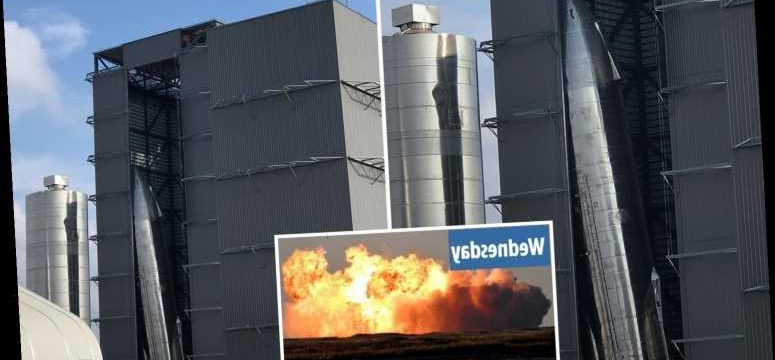ELON Musk’s SpaceX suffers its second rocket mishap in days as the new Starship prototype collapsed on its launch pad this morning.
The Starship Serial Number 9 (SN9) reportedly started to lean and eventually collapsed on its launch pad at the Boca Chia testing facility – days after the SN8 exploded in an huge fireball.
The stand holding up Musk's creation gave way, reports said, but the vehicle assembly building was in place.
This time, it caught the enormous rocket which then smashed into the ground after SpaceX’s SN8 unmanned test capsule blew up as it smashed into the ground on December 9.
The 160-foot tall SN8 completed its first high-altitude flight of 41,000 feet for 6 minutes and 40 seconds – but it ended in a dramatic explosion when it hit the ground.
Musk said SN8 was a success, however, because it reached its altitude target, as well as collecting data en route.
The SN9 was second prototype with wing tips, nose cone, and the same body design as the rockets before it. It's not clear whether SN9 was damaged today.
SpaceX said it was heading to the launch pad after SN8 took off in Boca Chica. It has built 10 Starship prototypes so far.
Musk's company said: "SN9 is almost ready to move to the pad, which now has two active stands for rapid development testing."
It was created by "building successive generations of prototypes" quickly to try them out rapidly.
SpaceX said: "SN8’s flight test is an exciting next step in the development of a fully reusable transportation system capable of carrying both crew and cargo to Earth orbit, the Moon, Mars, and beyond."
Its stainless steel model stands 160 feet (50 meters) tall and is 30 feet (9 meters) in diameter, reports said.
It flew over the Gulf of Mexico for five minutes before flipping sideways and free-falling back to the southeastern tip of Texas in a location near the Mexican border.
Musk dubbed this the "belly flop," a move designed to mimic the technique Starship when it's making its return journey through Earth's atmosphere from space
It represents the "belly" as it hits the atmosphere and decreases the speed of its descent as it nears the ground.
The "hop" is historic: previous SpaceX prototypes only hit 500 feet in the air – but it's also been extremely destructive as the craft went up in flames when it hit the ground.
It ruptured and debris was scattered everywhere as Musk hastily tweeted to confirm the SN8's High Altitude Flight Test had been successful.
The Tesla and SpaceX CEO wrote: "Successful ascent, switchover to header tanks & precise flap control to landing point!
"Fuel header tank pressure was low during landing burn, causing touchdown velocity to be high & RUD, but we got all the data we needed! Congrats SpaceX team hell yeah!!"
"Mars, here we come!!" he added in another tweet, followed by: "Thank you, South Texas for your support! This is the gateway to Mars."
His company has been developing two-stage-to-orbit heavy lift vehicle for the past eight years since 2012.
It's reusable design is supposed to bring the cost of launch.
SN8 isn't the first prototype SpaceX has exploded for experimental purposes or by mistake.
So far, its lost four prototypes during its journey, all of which have gone up in flames at the TX testing site.
Musk designed the Starship to one day haul satellites into the Earth's orbit, transport people around the world at record-breaking speeds, and one day settle on Mars.
The final design will require six engines as well as a "Super Heavy" rocket booster to push the spacecraft over 17,000 miles per hour and into orbit.
To reach Mars, the Starship will need to reach "escape velocity," which is about 25,000 miles per hour, and the speed needed to break free from the Earth's gravitational pull.
Source: Read Full Article








